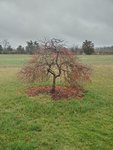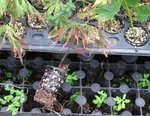Individual results will vary, but to get maple cuttings to root at a 75% or higher success rate, requires a fairly elaborate set up. If you also put some weeping willow cuttings in the glass of water with your maple cuttings, maybe one out of 25, to 1 out of 100 will root. Every time the willow cuttings sprout roots, take those out and put in a new set of weeping willow cuttings.
THe willow trick is weeping willow cuttings, before they root, leak natural rooting hormones into the water. Once the weeping willow cuttings root, they stop leaking hormones. An alternate is to use willow water to water your maple cuttings if you root them in a media like perlite & peat moss.
The point of my post, it is not impossible to root maple cuttings, but it is difficult. Even professional nurseries will use grafting for propagation of maples, because getting cuttings to root is difficult and not reliable.
Grafting is a good technique, but is also a technique that requires training and practice to get your success rate above 75%. But once you are proficient in grafting, your success rate can be above 90% for the cleft grafting used to propagate maples. But it takes practice. Like playing bagpipes, it won't be good for anyone the first time.



